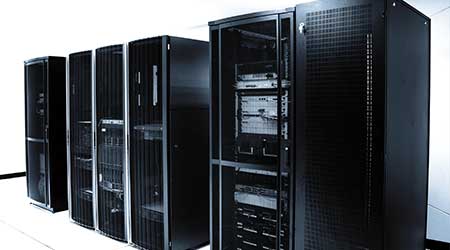« Back to Facilities Management Data Centers Category Home
How to Select PDUs for Data Centers
April 4, 2018
- Data Centers
By Evan Owen and Anand Krishna
Facility managers have a wide array of choices when selecting Power Distribution Units (PDU) for data centers. A good choice can bring the best economies, maximum scalability, and lowest lifecycle costs. Here are steps for selecting PDUs that typically reside in the grey/white space, downstream of the UPS and upstream of Remote Power Panels (RPP) and overhead busways that feed the server racks and storage equipment.
At a high-level, the considerations in selecting PDUs include these factors specific to the data center:
• Business strategy and goals.
• Systems architecture.
• Operating environment – driven by the type of customers that you target, or, if the data center serves internal needs, by the nature of the business.
• Capital vs. operating expense approach: High or low-level of “intelligence” and automation, driven by Capex vs. Opex considerations.
Attributes of PDUs and PDU original equipment manufacturers (OEMs) that factor into the selection process should include:
• PDU: power (kVA), K-factor (index of ability to withstand harmonic content), single output voltage or multiple-output voltages, front-access, and footprint.
• System: optimized PDU and static transfer switch (STS) connections and interworking.
• Advanced monitoring system.
• Size of OEM (ability to flex volume of shipments), manufacturing footprint.
• Ability to customize design to optimize for your needs.
Let’s dig a bit deeper into the four, high-level areas of consideration and how they should affect PDU selection.
1. Business Strategy and Goals
The business strategy and goals that influence PDU selection are likely to be driven by the business that the data center supports. Is the data center owner a cloud provider or social media giant, with explosive growth and geographic expansion? Maybe they are a colocation data center — one that hosts enterprises only — or also hosts cloud providers? Or perhaps they are an enterprise with steady growth? In addition, they could be data centers being built for edge applications, requiring small data centers in close proximity to where the data is consumed and generated?
Data center owners anticipating very high growth and capacity requirements should use high-power PDUs (500 kVA and higher) to get economies of scale — and the ability to add significant capacity in each increment. They should also pick OEMs that can flex volume shipments to match peak needs. Data center owners with gradual growth and small-to-medium capacity requirements can use smaller PDUs, to ensure economic utilization levels.
Data center owners going through a lot of geographic expansion, should ensure that the OEMs they pick have the footprint to provide competitive lead times.
2. Architecture
Data center architectures are evolving rapidly for a number of reasons.
• Some owners are building on an unprecedented scale — massive data centers, and new data centers being added in short periods of time; they are taking an “industrial” approach: scale-up rapidly, squeeze cost out, design once and build again, fast.
• Redundancy is being provided in new ways: multiple data centers, and software that enables redundancy across sites.
• Some data center owners are doing away with raised floors — to save money.
• Existing data centers that are being modernized present architectural constraints. Designers have to work with the available space and many other hard constraints.
• Many data center operators have large, highly technical staff who are innovating with the architecture to get the lowest cost and a competitive edge from their design.
How do these factors affect PDU selection?
• Data center owners building on an industrial scale should go with high-power PDUs, as noted earlier.
• Owners with architecture that employs STS should favor PDU suppliers who also build STSs. They are likely to enjoy efficiencies in installation and commissioning, as well as during the lifecycle of the equipment, as the PDU-STS interworking is optimized.
• For data centers that want the lowest attainable risk from a PDU failure, lower-power PDUs are the choice. If a low-power PDU fails, the number of servers or storage devices potentially impacted is less than if a higher-power PDU fails. Conversely, operators seeking to maximize scale economies should use fewer, high-power PDUs to lower installation and lifecycle costs, as well as footprint.
• Data center owners with raised floors should use PDUs with bottom-entry for cables. Otherwise, PDUs with top-entry for cables should be used.
Data centers that are space-constrained should favor PDUs that offer full front-access and have the smallest possible footprint.
3. Operating Environment
The environment in which IT equipment is operated is changing rapidly. The change is driven by factors such as the need for flexibility in the colocation industry, as these facilities often have customers with a wide variety of needs. Another consideration is regulatory pressure to increase safety (NFPA70E and OSHA). Finally, there is the spdeed and frequency with which capacity additions have to be made.
Other operations environmental considerations include the following:
• Data center owners with relatively steady, predictable growth should pick OEMs that have the supply chain and operations capability to take advantage of the predictable demand to get the best cost position. Conversely, operators with very rapid growth need OEMs that can flex their supply quickly.
• Customers with disparate voltage requirements (for their IT equipment) should use PDU OEMs that have the ability to provide multi-output transformers, i.e., PDUs whose output voltage can be changed easily, in the field.
• If there is a need to add circuits periodically after starting up the PDU, use equipment with compartmentalized sub-feeds or distribution so that circuits can be added without interrupting service.
• Data center owners who want to get the highest levels of safety (and are willing to spend more to achieve it), buy PDUs with state-of-the-art safety features, such as compartments for separate access to high-power and low-voltage sections to minimize exposure to high voltages, as well as compartments to separate distribution.
4. Capex/Opex Approach
Each data center owner’s approach to balancing Capex versus Opex varies. Those with data centers in very expensive and high-wage parts of the world are likely to spend capex upfront to maximize productivity. Operators running massive data centers are likely to spend Capex to automate, to minimize human error that could lead to outages. At the other end of the spectrum, owners of small edge data centers seek a “lights-out” approach, as their data centers are too small to justify having several employees operating each one.
Data center owners that aim for the highest level of automation and productivity — that is, are willing to spend Capex to minimize Opex — should pick PDUs with:
• Sophisticated monitoring of power parameters, thermal, one-line diagram showing equipment, fault detection, energy management, tenant billing, and high accuracy.
• Display that enables quick, easy monitoring, adjustment of configurations, and managing of alerts locally and remotely.
• Branch circuit, sub-feed, and panel-feed monitoring, breaker position status, equipment door position, programmable output relays.
In addition, operators that want to minimize the risk of failures by spending more should buy PDUs with bus (versus cable). Bussing is more costly but has fewer points of failure.
In conclusion, data center owners need to carefully assess their business strategy, architecture, operating environment, and approach towards capital versus operating expenses when selecting a PDU OEM. This extra consideration is needed because attributes of the OEM’s products, as well as engineering and operations capabilities, can have a significant impact on the data center’s competitiveness.
Evan Owen is global product manager, power distribution units, static transfer switch, magnetics, and Anand Krishna is vice president, business development for Power Distribution, Inc. (PDI).








